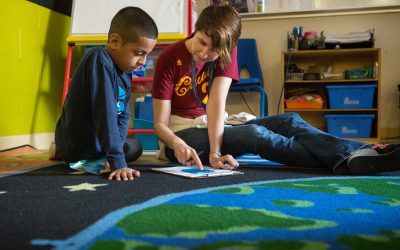Reflections on pedagogy that works for marginalized students
I have a confession: I hate class discussions.
I hate them because they remind me of baseball–which, however, I do enjoy. So please, let me explain.
In baseball, most of the time three players are involved in the action: the pitcher, the catcher, and the batter. Everyone else is standing around–or sitting on the bench–just watching. And if it’s little kid baseball, most of the people standing around are thinking, ‘Please, please, please … don’t hit it to me!’
During typical classroom discussions, a handful of students are participating. The teacher asks a question–pitching the ball–and the student swings (and maybe misses!) or the student who always participates grabs the question before it hits the ground and rolls away. Most everyone else in the room is thinking, ‘Please, please, please … don’t call on me!’ (Of course the other concern so many of us have, is that the whole room will break out in a heated argument, as all “rules of engagement” fall away).
Okay, so my metaphor–and claim to hate class discussions–might be a bit of an exaggeration, but wouldn’t it be better if everyone were actively engaged during class time, and if we ensured that all of our students had the opportunity to be heard, especially those whose past experience of school was one of marginalization or outright exclusion?
A common way to address the participation concern is to encourage students to take notes during the discussion, or to break the class into smaller groups and give everyone a specific role and responsibility. However, there are problems with these approaches.
First, following along with a free-flowing discussion, figuring out in real time what is important enough to record, and then taking notes–while not losing the thread of the conversation–can put significant strains on our cognitive bandwidth. Asking a student to do this when a topic is unfamiliar or while searching a text for evidence is not likely to be successful or to feel welcoming.
Second, the small group approach often simply disperses the problem. We’ve all seen–or been part of–groups that are dominated by one or two members. Assigning specific roles doesn’t really help much, since the artificial roles rarely equitably divide the responsibility and can force students to take on tasks–such as keeping time or acting as recorder–that actually dissuade them from meaningfully participating by contributing new ideas, synthesizing, or asking probing questions because it isn’t their ‘role.’
Third, and most importantly, neither of the approaches helps students acquire the skills to confidently contribute to the give and take of open-ended discussions, which is vital, because as much as I–and maybe you–dislike the standard class discussion format, it is not going away. To be college- and career-ready, all students must learn the skills to participate in the discussions that take place in the classroom and the conference room.
So what, then, is the solution?
Scaffolding discussion to foster meaningful learning
Rather than holding class discussions that exclude students and provide little opportunity to practice and apply the skills that genuine discussions demand, I’ve been thinking about ways we can create opportunities for genuine student-to-student interaction, which means that students collaborate to:
1. Ask and explore their own questions
2. Problem solve and read closely
3. Make meaning and synthesize new learning
The problem is that this is harder than it sounds. It take students time and practice, and ultimately, I’ve learned that it really only works when the classroom is built on a foundation of trust and safety…particularly with students whose voices have been ignored or silenced by the various institutions they have been part of. The implications of this for us, as teachers, are profound: we must be willing to facilitate student interaction that is initially likely to be messy, sloppy, sometimes profane, sometimes an abject failure…of silence or anger, of skepticism or cynicism….and sometimes all at once. For those of us who are used to feeling like we are “in control” of our classrooms, this is risky work. Just as it will take students time to learn to trust, and then to master the skills of academic discourse, it will take us time to learn to scaffold and support constructive, lively, self-disciplined discussions among students.
Take the risk to get students talking and learning…and ask them to take the risk as well
If the conversation in your classroom was a spider web, what would it look like?
Here, then, are six powerful scaffolded activities–drawn from reDesign’s collection of more than 200 learning activities–to get your students interacting with one another to deepen their learning, and practice speaking their minds and backing up their claims. With all of these activities, students will need modeling, multiple opportunities to practice, and supportively offered concrete and specific feedback.
As you jump into this work, consider three strategies that I have found accelerates student discussion skill-building:
- Talk with students about the social justice implications for learning to use one’s voice effectively while participating in academic discourse: the power of speaking, the need for marginalized voices to be heard loud and strong, the rigors of the college classroom
- Talk with students about your own journey to finding your academic voice, and also the journey of others who can be role-models. Help your students see that this is not a skill one is born with. And for those who are struggling with it, this is not a personal failing, but rather a failing of the system.
- Explain that the activities you are engaging in are for building the skills, it’s okay to be unsure of how to participate, or to fail to participate, or to over-participate: we are not judging and grading here, we are learning and it will probably take time to hone these skills.
- Make it abundantly clear in, words and actions, that this will not be another place where they will be silenced
- Find good models to show students: find and deconstruct videos and transcripts together
- Model participation and share your own questions and thoughts. And then, remind students that you are modeling, so that your contributions can be mined as the group hones its discussion skills: ask students to give you concrete and specific feedback
- Take time at the conclusion of the activity to allow students to reflect on the strengths and deltas of their participation, and to provide them with opportunities to identify specific goals and strategies they can use for improving their skills in the short- and long-term.
I really love this activity because it begins with questioning, which I would argue is the most powerful strategy for making meaning. Another plus is that it can be used with a wide variety texts and across content areas. Students generate questions, then collaborate to answer them using their text, providing a solid dose of practice reading closely
A close cousin to the teacher-led think-aloud, this activity pairs students to read a text aloud and share their metacognition with one another in real time. Don’t skip the last step, which provides a powerful opportunity for students to synthesize their thinking–the focus of the activity is not just the conversation, but the way the conversation helps students deepen their understanding of the text.
Another question-focused activity, this one incorporates a pair of scaffolds for students who may not be practiced at asking questions or actively participating in discussions: 1. sentence stems and 2. a clear back-and-forth structure. You can use well-chosen question stems to steer conversation in specific directions–for example, using “How are … and … alike?” sets up students to compare and contrast, and questions such as “What is the cause of … ?” and “What would happen if … ?” help students explore cause-and-effect relationships.
This is another personal favorite, especially with mixed-ability groups, since in the jigsaw classroom everyone gets the opportunity to be both an expert and a learner. When you thoughtfully pair students and texts–which can vary by level, genre, and perspective–and ask each group to read for a specific purpose, you can expose students to an array of texts in a very short time.
This activity is just for my math friends. It’s an amazing twofer–helping students develop both their problem solving skills and their metacognitive awareness. While it does assign students specific roles–boo!–it doesn’t confine them to any particular task–yeah! To pull this one off successfully, you want to check in with the groups to keep them focused on documenting their problem-solving process, not just at finding the answer.
This is one for people who like quiet. Unlike the other activities, which can raise the noise level in the room, this activity encourages deep thinking by providing the quiet environment some of us need to come up with a really great question or comment or insight. By using sticky notes, rather than voices, to communicate with one another, it provides wait time, taking the focus off being quick on our feet and putting it back on being thoughtful.
Bonus Assessment
Socratic Seminar: After you work with students on meaningful discussion habits, you might want to try a Socratic Seminar as a performance task. While on the surface a Socratic seminar might look like the kind of class discussion I (gently) mocked above, there are a couple of key features that distinguishes it. First, Socratic seminars have a pre-defined purpose to which the seminar moves–students work toward developing a shared understanding of an issue or text. Second, students have the opportunity to undertake a thorough preparation, generating questions, annotating texts, and gathering evidence. Third, the inner and outer circles of the seminar create an intentionality absent in ordinary discussions.
 Homework?
Homework?Here’s my challenge to you: if your plans for the next week include a class discussion, give one of these activities a try. If the activity fails, don’t give up, these activities really work! Assume (and communicate to students) that both you and the students need more practice, and try it 3 more times fairly rapidly (not necessarily the next day, or even that week, but soon!)…And let me know how it goes!
ABOUT GUEST AUTHOR JON ALTBERGS
In his first professional life, Jon was an English, Social Studies, and (occasional) Computer Education teacher in rural schools. In his second life, he worked variously as an AP, Dean of Students, Data Specialist, and Curriculum Coordinator. In his (current) third life, he is a member of reDesign’s design and knowledge building team. In real life, he lives in the woods of New Hampshire with his two sons, one wife, and two cats.
Join the community!
Sign up to receive our newsletter, access best-of educational resources, and stay in the know on upcoming events and learning opportunities. We hope to see you soon!




